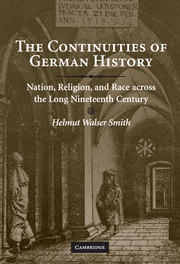Book contents
- Frontmatter
- Contents
- Introduction
- 1 The Vanishing Point of German History
- 2 The Mirror Turn Lamp: Senses of the Nation before Nationalism
- 3 On Catastrophic Religious Violence and National Belonging: The Thirty Years War and the Massacre of Jews in Social Memory
- 4 From Play to Act: Anti-Jewish Violence in German and European History during the Long Nineteenth Century
- 5 Eliminationist Racism
- Conclusion: Continuities in German History
- Acknowledgments
- Index
5 - Eliminationist Racism
Published online by Cambridge University Press: 05 June 2012
- Frontmatter
- Contents
- Introduction
- 1 The Vanishing Point of German History
- 2 The Mirror Turn Lamp: Senses of the Nation before Nationalism
- 3 On Catastrophic Religious Violence and National Belonging: The Thirty Years War and the Massacre of Jews in Social Memory
- 4 From Play to Act: Anti-Jewish Violence in German and European History during the Long Nineteenth Century
- 5 Eliminationist Racism
- Conclusion: Continuities in German History
- Acknowledgments
- Index
Summary
In Hitler's Willing Executioners: Ordinary Germans and the Holocaust, Daniel J. Goldhagen averred:
By the end of the nineteenth century, the view that Jews posed extreme danger to Germany and that the source of their perniciousness was immutable, namely their race, and the consequential belief that the Jews had to be eliminated from Germany were extremely widespread in German society.
As scores of historians familiar with late nineteenth-century German politics have argued, Goldhagen mistook political positions on the margin for positions at the center and willfully described as the mainstream a racial anti-Semitism ready to expel, if not kill, the Jews of Germany. Demonstrably, this position was not the mainstream, though the matter is more complicated than a simple recounting of the dismal electoral fortunes of political anti-Semitism would suggest. As Massimo Zumbini has recently argued, the career of racial anti-Semitism in the Second Empire occurred in two stages. In the founding years of organized anti-Semitism, 1879–1881, the new anti-Semites modernized and radicalized anti-Semitism, rendering it political, racial, and increasingly tied to pseudoscientific thinking. Yet as their project proved a failure, the anti-Semites drifted toward the political periphery, where their anti-Semitism became radical, and their paranoia evident. Eliminationist anti-Semitism, to take Goldhagen's term, cannot be said to be representative of public opinion in Imperial Germany, but it can be found at the periphery – in the work of anti-Semites like Theodor Fritsch, whose Handbook of the Jewish Question became a bible of the extreme right and openly advocated deportation of East European Jews and revoking emancipation legislation.
- Type
- Chapter
- Information
- The Continuities of German HistoryNation, Religion, and Race across the Long Nineteenth Century, pp. 167 - 210Publisher: Cambridge University PressPrint publication year: 2008

